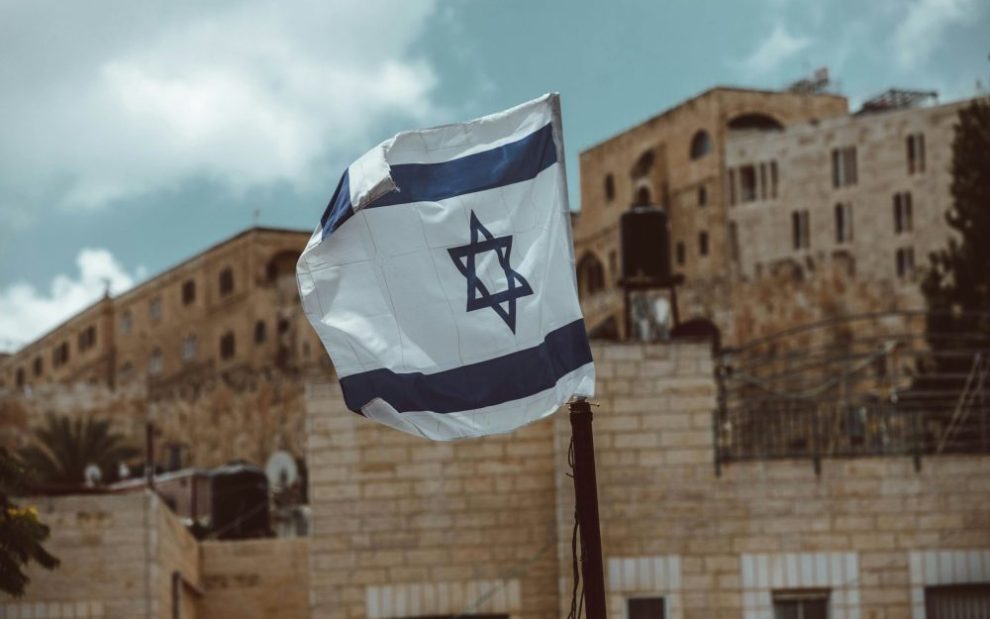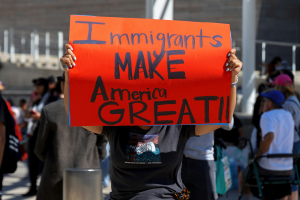Any journalist writing about the Israel-Hamas conflict should do so with humility. So let me state up front: I am not a Middle East expert, nor am I a theologian or a historian. But I am a cradle Catholic married to a Jewish atheist. His mother, when she was an 11-year-old child living in Hungary, barely escaped the Holocaust. Many of her aunts and uncles did not survive. Today, my husband has cousins living in Israel.
As I’ve watched my husband agonize over this conflict and how it’s perceived, I’ve realized my responsibility as a Catholic to expand my own understanding. The unexamined bias that has permeated Catholic thought and culture for millennia can shape the views we present-day Catholics have about this terrible conflict. History teaches us that Catholic prejudice helped light the fires of hate that ultimately led to the Holocaust.
The Holocaust, as well as the centuries of oppression, injustice, and disenfranchisement that preceded it, is a memory all Jews carry with them. That memory contributed to the fear and anger Israelis felt after Hamas’ brutal attack and hostage-taking last October.
Since then, the Israelis’ military response has prompted many critics, including some Jewish Israelis, to denounce their actions. People around the world are appalled at what they see as a disproportionate assault that has killed or injured more than 30,000 people in Gaza. Hamas has taken more than 200 Israeli hostages, but the Israeli government has shown little concern. The hostages’ families have protested their government’s focus on eliminating Hamas rather than freeing their loved ones.
Ceasefire negotiations and the return of remaining hostages will hopefully take place. But no temporary truce will heal the rift between Palestinians and Israelis.
As Catholics, given our church’s problematic historical relationship with both Jews and Muslims, we must cultivate a perspective that is informed by justice and truth. As we discuss this conflict with friends and acquaintances, we need to remember that Israel was founded as a refuge for Jews after millennia of pogroms and persecution—and Catholic teachings and prejudices fed that oppression.
Catholic antisemitism is less prevalent now than it once was, but we don’t have to go far to find one of the anchors of that prejudice: a passage from the Gospel of John that’s a cornerstone of the Good Friday liturgy.
In John’s account of Christ’s death, he cites the Jews and Jewish people more than 20 times—and not in a good way. John portrays the Roman governor Pilate in a more sympathetic light than he does the Jews. “Your own nation and the chief priests handed you over to me,” Pilate tells Jesus. “I find no guilt in him,” he says to the angry mob calling for Jesus’ death.
Pilate reminds the crowd that during Passover, custom dictates he releases one prisoner. He offers the people an option: release Jesus—or let Barabbas, an infamous rabble-rouser, go free. The people roar back their answer: “Not this one but Barabbas!”
Based on scriptures like this, Catholics have for centuries regarded Jews as the killers of Christ. The only way Jews could expiate their sin, the church believed, was to give up their faith and convert to Christianity.
Starting at the end of the 13th century and lasting five centuries, the church’s Inquisition exterminated thousands of “secret Jews,” charging them with the crime of false conversion to Catholicism. Jewish communities were often segregated from the rest of the population; tour any European capital, and you’ll see Jewish ghettos, reminders of the exclusion and suspicion Jews endured, usually at the hands of Catholics.
Catholics took far too long to mend their ways. In the 1890s, La Croix, a virulently antisemitic Catholic daily in France, ran a cartoon depicting the Rothschild banking family as a Jewish octopus extending its tentacles across Europe. A few years later, the paper called for the expulsion of Jews from France. In 2023, on the 140th anniversary of its founding, La Croix delved into the paper’s antisemitism that persisted until 1930.
Catholic antisemitism also happened a lot closer to home. In the 1930s, for example, Michigan-based Catholic priest Rev. Charles Coughlin drew audiences of millions to his weekly radio broadcasts, which were replete with antisemitic attacks. Coughlin referred to Jews as “modern Shylocks,” and his magazine reprinted portions of the Protocols of the Elders of Zion, a fictitious Jewish conspiracy to dominate the globe. Centuries of prejudice culminated in the Holocaust.
In light of this history of oppression and prejudice, is it any wonder that Jews wanted a country of their own, where they couldn’t be expelled, persecuted, or murdered?
Though the region of Palestine has repeatedly been at the center of violent disputes, Jews have lived there for thousands of years. But between the late 1800s and the 1930s, waves of Jewish immigrants moved into the region, most of them fleeing pogroms. They built the first kibbutzim, intentional communities that generated a thriving agricultural economy.
After World War I, Britain gained administrative control over Palestine. To retain Arab support against Germany and Italy, Britain began to sharply restrict Jewish immigration to the region in 1939, even in the face of Nazi atrocities.
The Vatican could have done more to take a stand against Hitler’s extermination campaign—but it didn’t. We now know, thanks to Pope Francis’s decision to open Vatican records, that Pope Pius XII thought he could negotiate with Hitler, despite his likely knowledge of Nazi atrocities.
After World War II, the numbers of Jewish settlers rose to more than 600,000. Jews who had managed to survive the Holocaust had nowhere to go. They had lost their homes and their livelihoods. Their homelands before the war didn’t want them back; Jews who did return to their original homes faced prejudice and violence. They longed for their own land.
In 1947, the United Nations set the Palestinian region’s boundaries of partition, giving Jews 56 percent of the land. The Jews accepted the partition; the Arabs did not. As soon as the new nation of Israel formed, the Palestinians and surrounding Arab states declared war on it.
Meanwhile, tens of thousands of Jews moved to Israel from around the world. They didn’t come to exploit the land’s natural resources or enslave its inhabitants. They came for survival. Many of them came because they had nowhere else to go.
But the Palestinians never accepted the loss of their land. For the past 75 years, Israel has ignored their protests and rebuffed their attacks—and Palestinians have continued to lose more territory and civil rights. Both sides have sometimes worked for a “two-state solution” that would give Israel greater security and offer Palestinians more economic opportunities and political power. But these initiatives have repeatedly faltered.
Despite some more peaceful periods, Israel’s policies have become more and more draconian. The current prime minister, Benjamin Netanyahu, has built a right-wing government that encouraged even more Israelis to settle in the West Bank, one of the areas Israel captured from Jordan in 1967. In the occupied West Bank, Israeli citizens have rights that Arabs do not share, while in Israel, Arabs, who make up about 20 percent of the population, have the same legal rights as Israeli citizens, yet face inequities in education, housing, and job opportunities.
We’re not being antisemitic if we criticize Israel’s oppression of Palestinians or its reckless campaign to destroy terrorists without concern for the thousands of civilians killed. But if we fail to condemn brutal terrorist attacks against Israel, we risk descending once more into Catholics’ ancient prejudice against Jews.
Hamas, which both the United States and the European Union consider a terrorist group, was not trying to defend itself. Reportedly, Hamas spent years creating a plan aimed at terrorizing Israeli families. The first Hamas strike killed about 1,200 Israelis, most of them civilians, many of them families. Experts from the United Nations have found evidence that multiple people were sexually assaulted during the attacks.
These tactics weren’t employed as a way to gain military advantage against an enemy government; they were intended to inflict as much pain, suffering, and fear as possible on a civilian population.
Neither side is completely innocent in this conflict. My spouse says, “I would like to see Netanyahu and his cabinet and the leadership of Hamas in the same dock at the same war crimes trial.”
But, as journalist Yair Rosenberg pointed out in a recent article in the Atlantic, Israel’s intent to destroy Hamas is not the same as the Hamas goal of eradicating the Israeli people. When commentators from prominent news agencies, including NPR, the BBC, and the New York Times, use the loaded word genocide to describe Israel’s military actions, they encourage the rise of antisemitic violence in this country and globally. We should be careful not to do the same.
For generations, the Catholic Church considered Jews to be Christ-killers—and the Vatican did not formally refute this belief until 1965. The U.S. Conference of Catholic bishops now makes clear that “the crimes during the Passion of Christ cannot be attributed, in either preaching or catechesis, indiscriminately to all Jews of that time, nor to Jews today. The Jewish people should not be referred to as though rejected or cursed, as if this view followed from Scripture.”
Today, this statement is included in the readings for Good Friday—but erasing centuries of internalized prejudice is not as simple as printing a few sentences in the lectionary. Catholic culture and teaching have fed us images of Jews as the evil “other” for far too long.
My parents, for example, weren’t consciously antisemitic, but I picked up from them the phrase “to jew someone down” to refer to haggling over a good bargain. In my Catholic high school, when we read The Merchant of Venice, the nuns didn’t feel the need to apologize for Shakespeare’s depiction of the “greedy Jew,” Shylock, out for his pound of flesh. A 2021 essay published by US Catholic examined the Catholic literary canon and found it replete with tropes such as Geoffrey Chaucer’s depiction of Jews as child murderers, G. K. Chesterton’s perception of Jews as aliens, and Hilaire Belloc’s condemnation of Jews as a problem people simply unable to be assimilated anywhere.
The violence in Israel and Palestine is horrific. It is also complicated, with deep roots in history. As Catholics, we have little power over the conflict’s outcome –but we can control how we talk about it. Whether we’re speaking of Jews or Muslims, we need to be sure our own implicit biases don’t color our views or our words.
And we need to take responsibility for our church’s history. We might start by asking church leaders to leave out of the lectionary that problematic passage from the Gospel of John. The Gospel of Luke’s account of Jesus’ death is far more nuanced, focusing on individuals, rather than blaming “the Jews.”
Amy-Jill Levine, a professor of New Testament and Jewish studies, reminds us that as Catholics, we need to consider what we teach—both directly and indirectly—to our children and our congregations. “In all cases,” she says, “we do well to determine how best to promote messages of love and compassion rather than of hate and damnation.”
Image: Unsplash/Taylor Brandon














Add comment